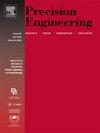A novel sensitivity analysis method for geometric errors in precision lathes based on variance decomposition and partial derivative integration
IF 3.7
2区 工程技术
Q2 ENGINEERING, MANUFACTURING
Precision Engineering-Journal of the International Societies for Precision Engineering and Nanotechnology
Pub Date : 2025-04-21
DOI:10.1016/j.precisioneng.2025.04.004
引用次数: 0
Abstract
Precision machine tools are influenced by geometric errors during the machining process, making the accurate identification of key geometric error terms essential for effective workpiece compensation and improved machining accuracy. However, current sensitivity analysis methods often overlook the interactions between high-order error terms, leading to inadequate efficiency and accuracy in error compensation. To address this issue, this paper proposes the VPM sensitivity analysis method, which is based on variance decomposition and partial derivative integration, considering the coupling effects of high-order geometric error terms. First, the volumetric error model of the tool-workpiece system in precision lathes was established using multi-body system theory and homogeneous coordinate transformation. Then, the VPM sensitivity analysis method was introduced, and a new sensitivity index Ni was defined. Based on the volumetric error model, Sobol and VPM sensitivity analysis were performed in different directions. Taking a cylindrical workpiece as an example, a turning test was carried out on a precision lathe. The results demonstrate that, compared to the traditional Sobol sensitivity analysis method, the proposed VPM sensitivity analysis method achieves superior convergence accuracy and enhances the roundness of the workpiece by 36.7 %, thus verifying the effectiveness of the method.
基于方差分解和偏导数积分的精密车床几何误差敏感性分析方法
精密机床在加工过程中受到几何误差的影响,准确识别关键几何误差项对有效补偿工件和提高加工精度至关重要。然而,现有的灵敏度分析方法往往忽略了高阶误差项之间的相互作用,导致误差补偿的效率和准确性不高。针对这一问题,本文提出了考虑高阶几何误差项耦合效应的基于方差分解和偏导数积分的VPM灵敏度分析方法。首先,利用多体系统理论和齐次坐标变换建立了精密车床刀具-工件系统的体积误差模型;然后,引入了VPM灵敏度分析方法,定义了新的灵敏度指标Ni。基于体积误差模型,在不同方向上进行Sobol和VPM敏感性分析。以圆柱形工件为例,在精密车床上进行了车削试验。结果表明,与传统的Sobol灵敏度分析方法相比,所提出的VPM灵敏度分析方法收敛精度更高,工件圆度提高36.7%,验证了该方法的有效性。
本文章由计算机程序翻译,如有差异,请以英文原文为准。
求助全文
约1分钟内获得全文
求助全文
来源期刊
CiteScore
7.40
自引率
5.60%
发文量
177
审稿时长
46 days
期刊介绍:
Precision Engineering - Journal of the International Societies for Precision Engineering and Nanotechnology is devoted to the multidisciplinary study and practice of high accuracy engineering, metrology, and manufacturing. The journal takes an integrated approach to all subjects related to research, design, manufacture, performance validation, and application of high precision machines, instruments, and components, including fundamental and applied research and development in manufacturing processes, fabrication technology, and advanced measurement science. The scope includes precision-engineered systems and supporting metrology over the full range of length scales, from atom-based nanotechnology and advanced lithographic technology to large-scale systems, including optical and radio telescopes and macrometrology.

 求助内容:
求助内容: 应助结果提醒方式:
应助结果提醒方式:


